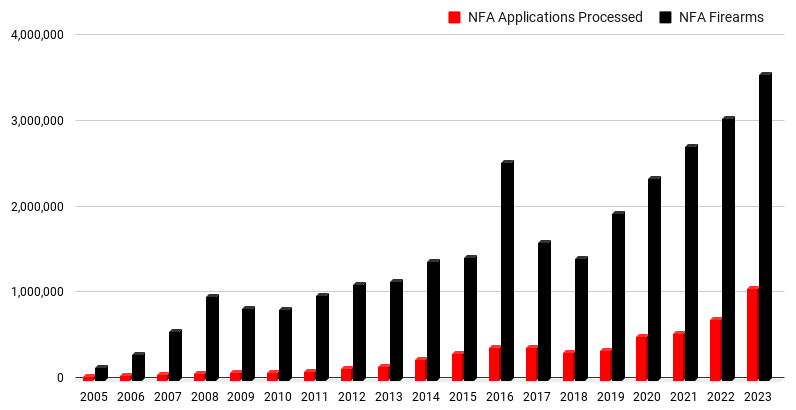New data from the Bureau of Alcohol, Tobacco, Firearms and Explosives (ATF) shows that the agency inspected more gun manufacturers, importers, and dealers — known as Federal Firearms Licensees (FFLs) — in fiscal year 2023 than it has since 2020. The ATF also uncovered significantly more violations of federal law during those inspections and revoked more licenses than ever before.
The data provided in the ATF’s “Facts and Figures for Fiscal Year 2023” fact sheet sheds more light on the Biden administration’s efforts to reinvigorate the ATF by increasing its funding, appointing its first Senate-confirmed director since 2015, and tasking the agency with prioritizing gun dealer inspections and revoking licenses for willful violations of federal law as part of the “zero tolerance” policy — something the National Shooting Sports Foundation, the gun industry’s trade association, has repeatedly railed against.
To learn more about the firearm supply chain and how it arms criminals, click here.
A CLOSER LOOK AT THE DATA
Several items stand out from the ATF’s latest fact sheet:
- In fiscal year 2023, there were a total 132,383 FFLs on record in the United States, a figure that has remained relatively consistent over the last decade.1ATF Facts and Figures for Fiscal Years 2015, 2016, 2017, 2018, 2019, 2020, 2021, and 2022.
- Of that total, 76,729 FFLs are licensed to deal in firearms, including 50,309 gun dealers, 6,417 pawnbrokers, and 20,003 gun manufacturers.
- The number of gun manufacturers (Type 7 FFLs) has effectively doubled since 2015 while most other FFL types — including gun dealers and pawnbrokers — have seen slight decreases. This may be because a Type 7 license allows a person or business to both manufacture and deal firearms, whereas a Type 1 gun dealer can only do the latter. It has also become much easier for people to build guns in recent years due to advances in technology.
- The ATF inspected 8,689 FFLs in FY 2023, a significant increase over the roughly 6,000 to 7,000 inspections the ATF conducted from FY 2020 to 2022. However, the ATF only inspected 6.6 percent of the 132,383 FFLs on record in FY 2023. (The inspection rate rises to 11.3 percent if limited to FFLs that can deal in firearms.)
- The ATF found violations in nearly 18 percent (1,531) of all FFL inspections in FY 2023. The most common violations included:
- 39,877 instances of FFLs failing to maintain accurate inventory records, meaning firearms may have been unaccounted for (up 19% from 2022);
- 28,588 instances of FFLs failing to complete required forms (up 28% from 2022);
- 20,738 instances of FFLs failing to complete Form 4473 transaction records (up 12% from 2022); and
- 5,408 instances of FFLs failing to report multiple sales of handguns (up 23% from 2022).
- Each of these violations can make it harder for the ATF to trace crime guns back to their first point of sale and disrupt trafficking rings.
- The ATF revoked the licenses of 170 FFLs in FY 2023 — nearly double the 90 revocations of FY 2022 and significantly more than 41 that the ATF averaged each year between FY 2015 and 2021. The ATF has provided revocation reports that show damning evidence of gun dealers who were cited for multiple violations of federal law.
- For the first time ever, the ATF processed over 1 million National Firearms Act (NFA) applications in FY 2023, allowing approved applicants to build, purchase, or transfer over 3.5 million NFA-regulated items, including machine guns, silencers, and short-barreled rifles and shotguns.
- ATF data shows that the number of NFA applications and weapons has grown exponentially in recent years.
- The ATF effectively doubled the number of NFA applications that it processed between FY 2021 and 2023. As discussed in this recent post, the ATF debuted a new online “eForms” system in December 2021 — after successful lobbying from the NSSF — that dramatically sped up the NFA application approval process.
